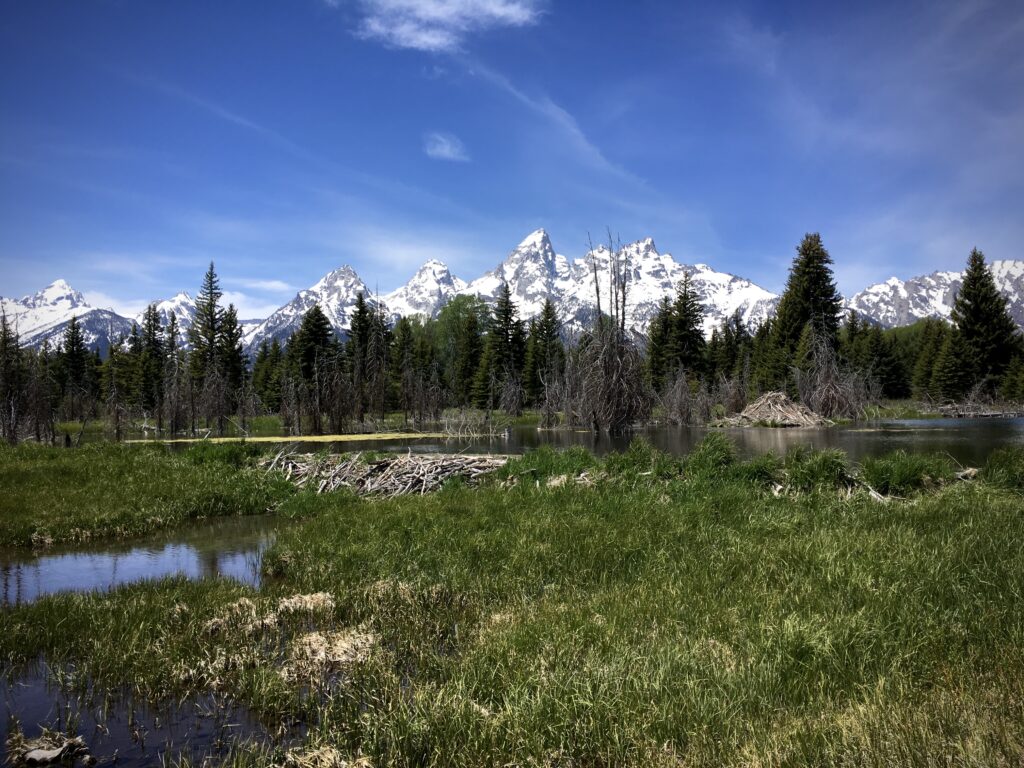Beavers have lived in Grand Teton National Park for thousands of years, according to a new analysis of ancient DNA found in lake beds. The finding demonstrates that beavers—which modify their ecosystems to an extent surpassed only by humans—may have kept plant and animal communities in the Tetons stable over millennia.
Beavers build dams and dig canals that transform waterways and ecosystems. Because their engineering creates new habitats for other plants and animals, beavers are often used as a restoration tool.
“We can use this going forward to understand where beavers were in the past, so we can know where we should put them in the future.”
Land managers look to the historical record to determine which ecosystems may benefit from beavers. But records are often incomplete: Scientists don’t know much about where or how beavers influenced ecosystems in North America before the fur trade wiped out much of the continent’s beaver population in the 1700s and 1800s. The new finding helps illustrate how these past ecosystems functioned.
“We can use this going forward to understand where beavers were in the past, so we can know where we should put them in the future,” said Nevé Baker, an evolutionary biologist and doctoral candidate at the University of California, Santa Cruz and lead author of the new study.
Buried Beaver DNA
All living things shed DNA into the environment, through dead skin cells, hair, excrement, and other bodily fluids. Even millions of years later, scientists can collect this environmental DNA (eDNA) and determine which species left it behind. Lake environments are especially great for finding ancient eDNA, because they’re shielded from Sun damage and most microbial activity, Baker said.
In their search for ancient beaver DNA, Baker and her team took sediment core samples from three lakes in Grand Teton National Park. One, Lake Solitude, was used as a control. Because Solitude is an alpine lake fed by snowmelt, the researchers didn’t expect to see evidence of beavers there and didn’t find any ancient beaver DNA. But ancient beaver DNA showed up in sediment from the other two lakes: Taggart Lake and Jenny Lake.
In both lakes, the team detected ancient beaver DNA in sediment from 7,250 years ago. Further analysis of the sediment cores showed that beavers have existed at Taggart Lake continuously (at least every 500 years) since about 5,000 years ago. Ancient beaver DNA detections in Jenny Lake were less continuous.

The evidence uncovered by the research team showed that beavers were present during a regional shift to more wintertime precipitation and the growth of more water-loving trees such as poplars and willows, Baker said.
Although beavers might be responsible for the shift in vegetation, it’s also possible that they showed up in the region because the climatic shift influenced what was growing. “It’s kind of like, ‘What came first, the beaver or the poplar?’” said Emily Fairfax, an ecohydrologist at the University of Minnesota and a member of the research team.
Baker and Fairfax and their colleagues will present their results on 14 December at AGU’s Annual Meeting 2023 in San Francisco.
Reconstructing Dam Constructors
The new approach to piecing together beaver habitats could be helpful elsewhere. In California, for example, a beaver restoration program created this year is working to establish the animals in some ecosystems to help promote the return and persistence of other important species. But before they can be introduced, policies in the state’s Department of Fish and Wildlife require program staff to demonstrate that the area is within beavers’ native range.
“There’s this missing piece that we can finally characterize.”
“Given the implications of the fur trade and the extirpation [of beavers] from many watersheds, we know that their current range does not reflect their historical, native range,” said Valerie Cook, program manager for the state’s beaver restoration program. Ancient DNA evidence, such as that found by Baker’s team, can provide the scientific evidence needed to allow program staff to introduce beavers, she said.
Looking for ancient beaver DNA can help answer questions about how ancient novel ecosystems arose, too. The existence of beavers in a past ecosystem could explain, for example, confusing shifts in carbon storage in soils or perplexing pollen records. “There’s this missing piece that we can finally characterize,” Fairfax said.
—Grace van Deelen (@GVD__), Staff Writer


